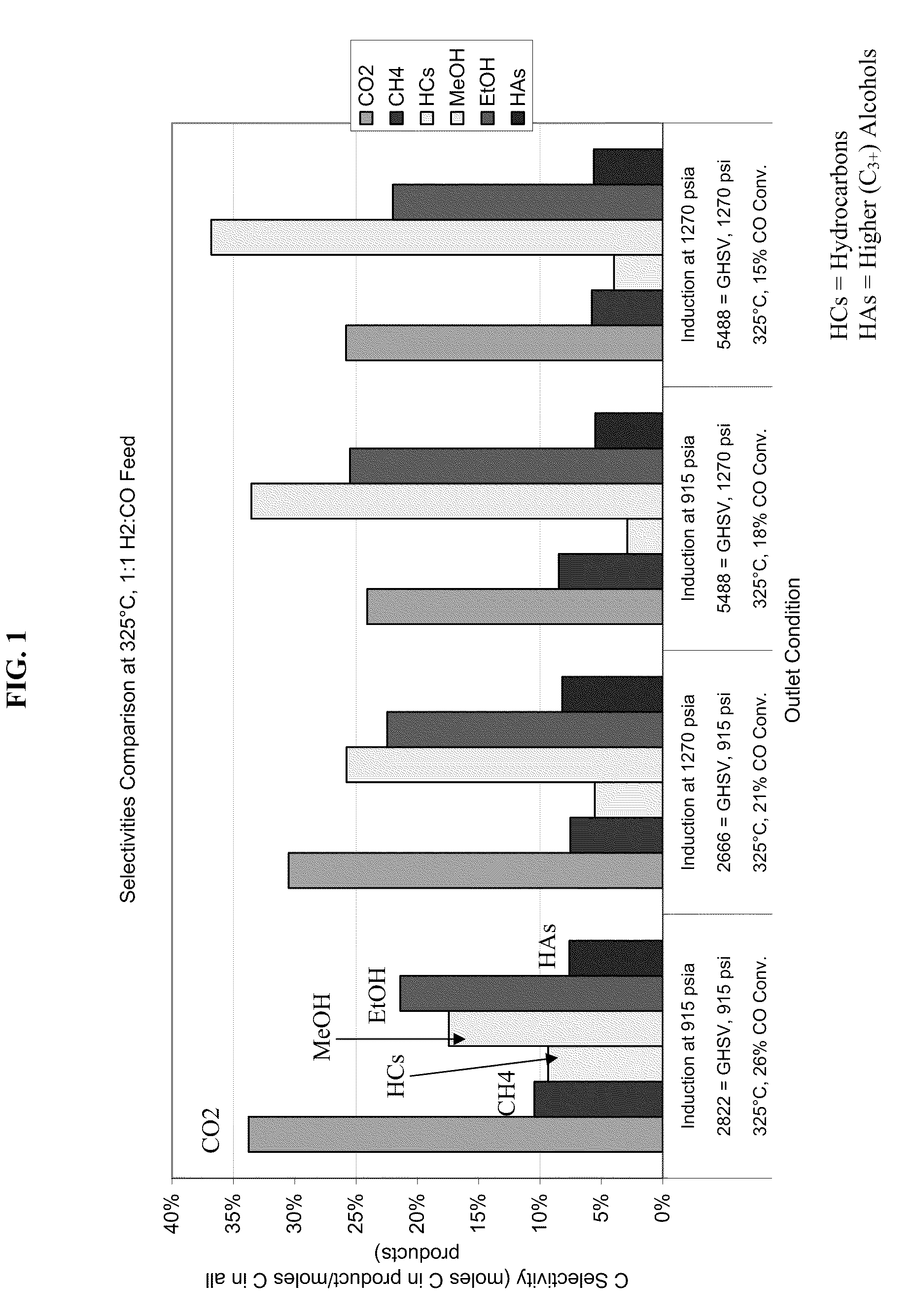Methods for improving syngas-to-ethanol catalyst selectivity
a technology of ethanol catalyst and selectivity, which is applied in the direction of physical/chemical process catalyst, bulk chemical production, metal/metal-oxide/metal-hydroxide catalyst, etc., can solve the problem that the known catalyst used in the conversion of syngas to alcohol can have limited yields and selectivities to particular alcohols
- Summary
- Abstract
- Description
- Claims
- Application Information
AI Technical Summary
Benefits of technology
Problems solved by technology
Method used
Image
Examples
example 1
[0055]A catalyst is prepared wherein the catalyst composition comprises Co and Mo, combined with atomic ratio of Co to Mo of about 0.5. The catalyst composition also comprises sulfur, in an atomic ratio of S to (Co+Mo) of about 2. Potassium is introduced as K2CO3 so that the atomic ratio of K to (Co+Mo) is about 0.4. Thus 10 g of catalyst powder having a formula Co1Mo2S6 is promoted by the addition of 1.9 g of K2CO3 (anhydrous). This catalyst composition is subjected to various experiments as described in the following examples.
example 2
[0056]An experiment is carried out by first activating the starting catalyst in accordance with Example 1 at a pressure of 1270 psia in 1:1 H2:CO. Then, the activated catalyst is evaluated at a pressure of 1270 psia at temperatures of 310° C. and 325° C. The activated catalyst is also evaluated at a pressure of 915 psia at temperatures of 310° C. and 325° C. It is observed at 325° C. (FIG. 1) that the carbon-atom selectivity to methanol is higher than that to ethanol.
example 3
[0057]An experiment is carried out by first activating a starting catalyst in accordance with Example 1 at a pressure of 915 psia. The activated catalyst is then operated at pressure of 915 psia at temperatures of 310° C. and 325° C. This activated catalyst is also operated at a pressure of 1270 psia at temperatures of 310° C. and 325° C. The results are summarized in the chart shown in FIG. 1, for a temperature of 325° C. When the catalyst activated at 915 psia (“Induction at 915 psia”) is operated at 915 psia, higher C-atom selectivity to ethanol than to methanol is observed. It is hypothesized (without being limited to any particular explanation or theory) that higher ethanol / methanol ratios arise, at least in part, due to more-effective catalyst activation.
[0058]In this detailed description, reference has been made to multiple embodiments of the invention and non-limiting examples relating to how the invention can be understood and practiced. Other embodiments that do not provid...
PUM
| Property | Measurement | Unit |
|---|---|---|
| Temperature | aaaaa | aaaaa |
| Temperature | aaaaa | aaaaa |
| Temperature | aaaaa | aaaaa |
Abstract
Description
Claims
Application Information
 Login to View More
Login to View More - R&D
- Intellectual Property
- Life Sciences
- Materials
- Tech Scout
- Unparalleled Data Quality
- Higher Quality Content
- 60% Fewer Hallucinations
Browse by: Latest US Patents, China's latest patents, Technical Efficacy Thesaurus, Application Domain, Technology Topic, Popular Technical Reports.
© 2025 PatSnap. All rights reserved.Legal|Privacy policy|Modern Slavery Act Transparency Statement|Sitemap|About US| Contact US: help@patsnap.com


